This survival game by ex-Blizzard devs aims to solve the genre's biggest problems
How Ark, World of Warcraft, and League of Legends come together for a new type of survival game.
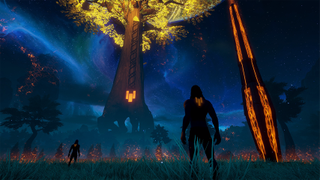
As Steam Early Access chokes up with ever more survival games, differentiating one from the next isn't easy. For the first few minutes of watching Rend, I thought it would be just another emaciated face in the crowd. But then Frostkeep Studios co-founder Solomon Lee turned his character to face a gargantuan tree that dominates the skyline in the middle of the map.
Etched in the tree's bark is a magical meter that charts the progress of each of three player factions vying for control of the map and its resources. If a faction can protect their Divinity Stone long enough to fill the meter or destroy the other teams' stones, they win. The server resets and all three teams start again. Rend might be a survival game, but its League of Legends inspirations are clear.
Blending genres
"We spent a lot of time digesting what the survival genre is all about," Frostkeep Studios co-founder Matt Milizia says. "It has some crazy high points that you don't see outside of the genre, and it also has a bunch of accepted pain points that often prevent you from experiencing those high points. What we set out to do was build a game around those high points and bring in a lot of elements from other genres to smooth the experience out and be more fun for everyone."
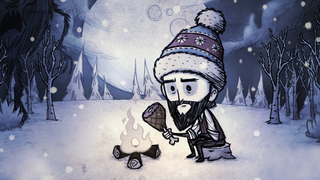
Trying to stay alive is hard-coded into our DNA, so it makes sense that we'd become so engrossed in doing it virtually. But what are the best games in the genre? Find out in our detailed list.
The product of that effort is Rend, a survival game that blends the RPG progression of World of Warcraft and the competitive nature of League of Legends with a gooey survival-game filling as its heart. Instead of waking up naked and alone when making a new character, players automatically join one of three factions and spawn inside that faction's home base where their precious Divinity Stone is located.
If that stone is destroyed, the faction is wiped from the server entirely until one of the other factions wins. Fortunately, a magical barrier protects the stone from harm except when, once a week, each faction's shield drops. Called the Time of Reckoning, waves of demons assault each fortress and factions will need to muster their players to repel the oncoming onslaught. "It's like scheduling a raid night in World of Warcraft," Frostkeep co-founder Jeremy Wood says.
Each server will be able to set its own schedule for when the Time of Reckoning happens, so players will hopefully be able to play on a server where their real-world schedule allows them to log in during the event.
Once the Reckoning is over, the shields will remain down for a period of a few hours, opening up the possibility for a more concentrated PVP experience. But here's the kicker, each week the demons get stronger and stronger, effectively putting a serious deadline on how long a faction can hold out. Regardless of how strong you are, if you're not able to defeat the other two factions in time, the demons will eventually destroy everyone. "You have to continue to upgrade your tech as a guild to make sure you're keeping up with the power of the things attacking you and the factions that are also raising their tech," Wood says.
The biggest gaming news, reviews and hardware deals
Keep up to date with the most important stories and the best deals, as picked by the PC Gamer team.
In order to win, players must deposit souls into their Divinity Stones. Each in-game night, the three valleys that each faction calls home will become plagued with lost spirits that can be collected and deposited into the Stone. Of course, dying with your cache of spirits means other players can steal them for their own faction. Souls are also a resource used in crafting and leveling up, so players will need to juggle between banking them for a win or spending them on advancing their technologies.
My best experiences in survival games is when you're fighting against a guild that's the same size and same footing. We're trying to deliver that kind of experience rather than a total lopsided fight.
Matt Milizia
Every action in the game also feeds into a skill system that will differentiate players from one another. Some will focus on crafting while others might pursue more combat oriented roles. One of the most interesting specializations is the mystic, which can conjure portals to alternate dimensions (more on that below).
Of course, Rend will also allow players to make private servers that can toggle any of these settings how they see fit. Want to play with no base shields or forgo the Reckoning altogether? Milizia promises that kind of freedom.
To keep things competitive, each faction can only have 20 players logged on at one time (though that number might increase further into development). "It's just much more interesting in far as having a community and having a war where the numbers are even," Milizia explains. "My best experiences in survival games is when you're fighting against a guild that's the same size and same footing. We're trying to deliver that kind of experience rather than a total lopsided fight."
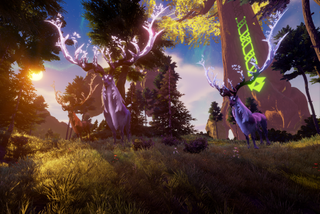
But there's another, equally as important reason: performance. Throughout the demo, Milizia, Lee, and Wood were constantly emphasizing that, for them, performance is one of the highest concerns. For anyone who has marvelled at how gorgeous a game like Ark looks in screenshots only to turn off all those settings to even have a hope at a passable framerate, this is good news.
To demonstrate this, the demo version of Rend they showed me was running on a laptop (albeit a gaming one) and appeared to maintain a smooth 60 frames without noticeable graphical drawbacks. Rend's artstyle is a clear evolution from the design aesthetic of World of Warcraft, which Milizia worked on as an environment artist. While considerably less cartoony than Warcraft, Rend leans more on a striking art style than bleeding-edge graphics. "Ultimately [Rend is] a shooter, so performance is king," Wood says. "Trying to have strong shooter gameplay while running at a low framerate is not fun."
Caves, wastes, and spirit worlds
Milizia tells me that, in the beginning, Rend will feature a lot of the same ideas present in other survival games—chiefly punching shit until it breaks into craftable shit. But before long, Rend's unique features take the game well beyond the normal gather-craft routine players are familiar with.
Instead of just copying basic survival game features wholesale, Frostkeep Studios is reinventing the wheel wherever they can. Take taming for example, which in Ark means standing around for minutes to hours while a subdued animal slowly eats food. It's a system that's boring as often as it's frustrating. There's a reason why most private servers have jacked the rate at which animals tame through the roof.
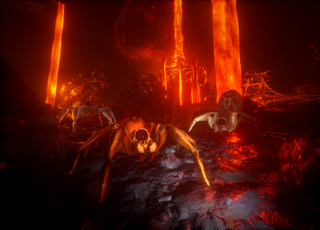
In Rend, however, taming opens up a portal to a world of possibilities—and I mean that literally. While killing animals in the wild, there's a chance that their departing spirit might open a rift to a spirit world that is a spectral mirror of Rend's own map. Inside this world, players will need to chase down the animal spirit to siphon its essence in order to call upon it as a mount while dealing with deadly spirit monsters. But the spirit world isn't just a place for taming, it has its own rare resources that can't be found elsewhere. What's more, players can enter and exit at different locations, opening up opportunities for sneak attacks on enemy factions.
That multi-purpose design stretches across many of the different zones in Rend. A cave network provides access to each faction's valley while also offering its own rare resources that players will eventually need to access in order to keep advancing. And then there's my favorite part, the Eternal Wastes, a frozen hellscape that really drives home Rend's survival game inspirations.
The idea is to ramp up the insanity near the end and just let people have fun.
From what Lee showed me in the demo, the wastes are a miserable nightmare where an ever-present blizzard billows across a sunless expanse. If the elements don't kill you, the terrifying monsters hidden in the swirling snow will. But these wastes also conceal tombs that can be opened by any player possessing the key. Boss monsters that Milizia compares to those from World of Warcraft dungeons lurk inside each one.
If a faction can gather up a team of players and take down the boss, one player will be rewarded with an artifact item—a piece of equipment that grants supernatural powers. Some let you jump 30 feet in the air, teleport short distances, or turn entirely invisible. The kicker? There's only one of each type of artifact item per server. "By the time you're able to get this far in the game and looting these tombs, someone is getting close to winning," Wood explains. "The idea is to ramp up the insanity near the end and just let people have fun."
"We want big swings, and memorable moments," Milizia adds.
With hordes of demons attacking each week and players wielding items that grant superpowers, Rend's endgame sounds like an explosive finale to month's of effort.
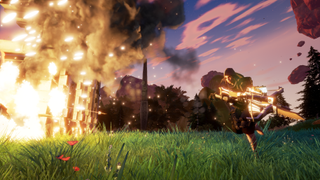
Surviving Early Access
If there's one aspect of survival games that Rend won't be subverting, it's the trend of nearly every survival game going through Steam Early Access. Despite Milizia's insistence that Rend "won't be on Early Access forever," it's the same thing we've heard from other survival game developers before. It means that, even if performance is top-notch like the team says it will be, players will still be beta testers in yet another unfinished game. And if other survival games are anything to go by, that means likely enduring bugs, growing pains, and an overall lack of polish.
That said, I'm very interested in playing Rend when it releases later this spring. I love the idea of a survival game that isn't just another open-world sandbox but one that funnels players directly into combat each week. During the hour-long meeting I had with the three founders of Frostkeep, I lost track of the times I got a little excited by one small idea or another that will not only lead to conflict, but also make it interesting.
For example, the underground caves are suitably pitch-black and players will need to use light sources to navigate them. The only problem is that enemy players will be able to see you at the same time. Because the caves are narrow and ultimately connected, there's plenty of potential for ambushes and other PVP shenanigans. But players who specialize as mystics can create light sources only their faction can see. Just like any good competitive multiplayer game, for every choice there is a strong counter.
Aside from the obvious caveats of being Early Access, almost everything about Rend seems unique and thought out. It could just end up being the push the survival genre needs to stop resting on the same tired designs with each new game. For now, Rend has me feeling optimistic about a genre that I'm quickly tiring of.






With over 7 years of experience with in-depth feature reporting, Steven's mission is to chronicle the fascinating ways that games intersect our lives. Whether it's colossal in-game wars in an MMO, or long-haul truckers who turn to games to protect them from the loneliness of the open road, Steven tries to unearth PC gaming's greatest untold stories. His love of PC gaming started extremely early. Without money to spend, he spent an entire day watching the progress bar on a 25mb download of the Heroes of Might and Magic 2 demo that he then played for at least a hundred hours. It was a good demo.
Most Popular

